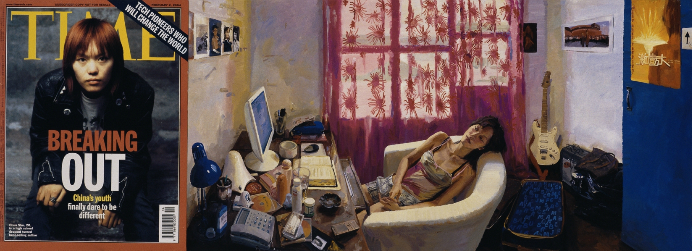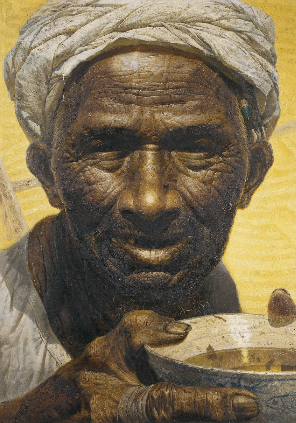Openness and Integration
Exhibition
Contemporary Chinese Art Exhibition
Museum of Fine Arts
| Magyar Múzeumok Online |
2012-08-09 11:05 |
The exhibition Openness and Integration hosted by the Museum of Fine Arts provides an overview of Chinese art from the last thirty years. The National Art Museum of China selected some 120 oil paintings, traditional Chinese ink-and-wash paintings, drawings, prints and sculptures with the aim of providing a cross-section of theartistic trends of the recent past, the complex techniques applied by artists as well as with the diversity and wealth of Chinese art.

The exhibition showcasing the art of the period from 1978 to the present day covers a floor space of almost two thousand square metres and approaches this colourful world of art from three perspectives. The works displayed in the section The Adversities of Time reflect the social developments of the reform period in China, The Poetry of Nature illustrates how Chinese landscape painting with its tradition of over one thousand years continues even today, while The Delights ofDiversity shows the various trends that co-exist side by side, e.g. those of East and West, and old and new.
The flourishing of contemporary Chinese art has taken place in tandem with economic growth. The art of the last three decades in a country that has embraced the challenges of globalisation is intricately interwoven with China’s social reality, which since the declaration of the People’s Republic of China in 1949 has been in a state of continuous change. The trends that came from Europe and North America exerted a meaningfully significant impact upon contemporary Chinese art (beginning with Expressionism through Pop Art right up to Action Art); the search for different ways of seeing things and new tools of expression resulted in the kind of processes that have lasted to the present day, and which themselves integrate the new but nevertheless maintain links with traditions, albeit at varying levels of intensity. The experiments of the artists seeking to develop a novel visual language have brought forth works created with the most diverse mediums and techniques: beyond ink-and-wash and oil paintings, drawings and woodcuts, photography and video art have also attained accentuated significance in the Chinese art of recent decades.
Directly after 1949 art traditionally served as a vehicle for representing ideals rather than a means of accurate representation of reality, while in many cases artists were forced to work in isolation, secluded from the world. The classic monochrome ink-and-wash pictures depicting birds, flowers and landscapes proclaimed the philosophy of the unity of man and nature through the use of visual tools; however, they slowly became obsolete since they were no longer suitable for the realistic representation of tangible reality. In the meantime, the oil painting technique adopted from Europe became the government’s most favoured tool enabling it to superbly depict historical-revolutionary events and figures. Moreover, during the “cultural revolution” between 1966 and 1976 the art scene virtually ceased to exist with artists being vilified and exiled to the provinces.
 From 1978, under the leadership of Deng Xiaoping, ideological trends of a new kind began to define the development of Chinese art. The contemporary trends that came from the West questioned the purely realistic artistic approach and prompted artists to experiment with modern tools of expressive while at the same time encouraged them to rethink traditional artistic forms. By fusing the artistic tools of abstraction and expressionism with the spirituality of traditional Chinese painting a new style emerged in this period. Further new trends appeared in the 80s and 90s, including “rural realism”, which depicted themes taken from the countryside, “classicism” with its roots in Europe, as well as Avant-garde trends borrowed from Western art, such as Expressionism (which appealed to Chinese artists because of its highly subjective symbolic content), Surrealism and Hyperrealism. In addition to Avant-garde trends the old genres also gained impetus in Chinese art, albeit with a significantly renewed content. Pictures made with the traditional ink-and-wash technique and woodblock printing preserving classical Chinese aesthetics and symbols are still present today, although they now reflect an image of modern society.
From 1978, under the leadership of Deng Xiaoping, ideological trends of a new kind began to define the development of Chinese art. The contemporary trends that came from the West questioned the purely realistic artistic approach and prompted artists to experiment with modern tools of expressive while at the same time encouraged them to rethink traditional artistic forms. By fusing the artistic tools of abstraction and expressionism with the spirituality of traditional Chinese painting a new style emerged in this period. Further new trends appeared in the 80s and 90s, including “rural realism”, which depicted themes taken from the countryside, “classicism” with its roots in Europe, as well as Avant-garde trends borrowed from Western art, such as Expressionism (which appealed to Chinese artists because of its highly subjective symbolic content), Surrealism and Hyperrealism. In addition to Avant-garde trends the old genres also gained impetus in Chinese art, albeit with a significantly renewed content. Pictures made with the traditional ink-and-wash technique and woodblock printing preserving classical Chinese aesthetics and symbols are still present today, although they now reflect an image of modern society.
Following the spirit of “reform and openness” the institutional system also underwent a restructuring with restrictions lifted and freedom granted for artistic experimentation. The Chinese art of the last three decades can be characterised by unprecedented change and along with this process the international recognition of Chinese artists has grown. Contemporary Chinese artists are now regular participants at international exhibitions; moreover, in 2011 five of the ten artists generating the highest earnings at international auctions were Chinese with 212 million dollars being paid for the art of Wu Guanzhong, some of whose works will be showcased at the Budapest exhibition.
The exhibition will display the fine art of China in the last thirty years in three chapters:
The Adversities of Time
After the 1978 policy of “reform and openness” was declared the artists that had been exiled were allowed to return to their profession and the training of new generations of artists also began. Artists strove to detach themselves from the standard depiction of social realism and a wealth of new trends emerged. The initial years saw the development of the art of “scars”, which was an attempt to come to terms with the tribulations of the preceding decades. In the framework of the forming ideological vacuum artists tried to find resolution to issues defining the life of the nation and along with this sought to discover their own identities. In addition to depicting historical-political themes Chinese artists strove to accurately capture the rapidly changing Chinese reality that surrounded them and they depicted real people and lives in their pictures instead of the idealised workers and peasants of the previous era. New themes were provided by urbanisation, globalization as well as the relentless progress of the market economy and fundamental changes in society. Rapid growth has brought along with it new opportunities and a deep sense of optimism but at the same time new problems were continually coming to the surface. The works in this section are not merely works of art but also documents of a turbulent era.
 The Poetry of Nature
The Poetry of Nature
The approach of Chinese landscape painting, which stretches back over one thousand years, fundamentally differs from its western counterpart: its objective is not to depict a given landscape but instead to capture the relationship between man and nature and to represent an ideal spiritual home. Chinese landscape pictures do not depict actual landscapes but rather the internal world of the painter. A break took place with ancient traditions between the 1950s and 1970s, in which time man became the conqueror of nature instead being a part of it. However, from the 1970s onwards the notion of the unity of man and nature was revived and Chinese landscape depiction returned to its roots. At the same time, the genre was renewed to a major extent. Artists in China have now broken out of the constraints of traditional ink-and-wash painting with some landscapes being made with western oil painting and modern graphic techniques, and traditional ideals are embraced by using the most diverse of materials, approaches and styles. Some artists aim for a spatial depiction of the landscape but now the rules that used to govern the kinds of landscapes that could be depicted are no more.
The Delights of Diversity
In the new era Chinese artists are free to choose their themes and techniques, and can bravely experiment and seek their own artistic modes of expression. The world has opened up before them and they are able to blend the old with the new, and Chinese with foreign art, thus creating their own unique idiom. The many and diverse styles and techniques have made the Chinese fine arts of today extraordinarily colourful, varied and dynamic: traditional ink-and-wash painters and postmodern media artists work side by side with the representatives of realistic oil painting and abstract experimentation, influencing each other. Both traditional genres and contemporary trends are experiencing a golden age. The boundaries between the various branches of art have become indistinct and traditional categories are no longer applicable in China either. The Chinese art scene has become international: Chinese artists now form part of and indeed shape global trends, while striving to preserve their own national characteristics.
Openness and Integration
Contemporary Chinese Art Exhibition
Museum of Fine Arts
10 August – 9 September 2012